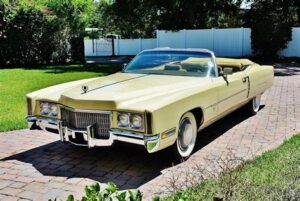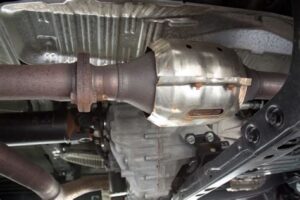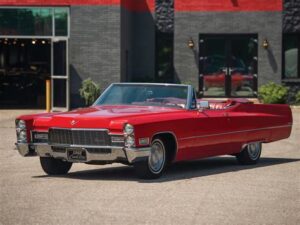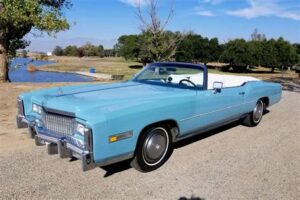In the competitive world of automotive performance, the importance of a high-quality Mercedes Cadillac converter cannot be overstated. Designed to optimize your vehicle’s emissions control and enhance overall efficiency, this essential component plays a pivotal role in maintaining your Mercedes’ peak performance. Whether you’re a seasoned car enthusiast or a casual driver, understanding how to identify and replace a faulty converter can lead to significant improvements in both your vehicle’s performance and longevity. In this article, we will explore the key aspects of the Mercedes Cadillac converter, uncover the signs of failure, and provide you with effective steps for replacement. With a new Mercedes Cadillac converter, you can expect a noticeable impact on your vehicle’s power and efficiency—transforming your driving experience for the better. Let’s dive into everything you need to know about this crucial automotive component.
Understanding The Importance Of A Mercedes Cadillac Converter
The mercedes cadillac converter plays a critical role in the overall performance and efficiency of your vehicle. As a crucial component of the exhaust system, its primary function is to convert harmful gases produced during fuel combustion into less harmful substances before they are released into the atmosphere. This process not only helps in reducing vehicle emissions but also enhances fuel efficiency, thus contributing to environmental conservation.
A well-maintained mercedes cadillac converter ensures that your vehicle complies with emission standards and regulations. It also aids in optimal engine performance. A failing converter can lead to increased emissions, decreased fuel efficiency, and potential damage to other parts of the exhaust system, resulting in costly repairs.
Moreover, a functional mercedes cadillac converter can prevent engine misfires, improve acceleration, and eliminate the risk of failing an emissions test. Therefore, recognizing its importance and ensuring its proper maintenance is vital for any Mercedes or Cadillac vehicle owner.
| Function | Impact of a Healthy Converter | Consequences of a Faulty Converter |
|---|---|---|
| Reduces Emissions | Maintains compliance with environmental regulations | Increased harmful emissions |
| Enhances Fuel Efficiency | Improved fuel economy | Decreased fuel efficiency |
| Engine Performance | Better acceleration and power | Engine misfires and potential damage |
Understanding the significance of the mercedes cadillac converter is crucial for maintaining not just the performance of your vehicle but also its environmental impact. Regular check-ups and timely replacements are essential to ensure the longevity of this important component.
How To Identify A Faulty Mercedes Cadillac Converter
Identifying a faulty mercedes cadillac converter is crucial for maintaining your vehicle’s performance and compliance with emissions regulations. Here are some effective methods to determine whether your converter may be compromised:
1. Check Engine Light: One of the first indicators of a problem is the illumination of the check engine light. If this light appears on your dashboard, it may signal issues with the mercedes cadillac converter, among other potential problems.
2. Unusual Noises: Listen for any unusual sounds coming from the exhaust system. A faulty converter may produce a rattling noise, indicating that the internal components are breaking down.
3. Decreased Performance: Noticeable drops in acceleration or overall engine performance can also indicate a malfunctioning converter. If your vehicle struggles to accelerate or exhibits sluggish behavior, it’s time to inspect the mercedes cadillac converter.
4. Foul Odors: A failing converter can lead to a build-up of unburnt fuel and may emit a strong smell of rotten eggs due to excessive sulfur. If you detect this odor, your converter could be the culprit.
5. Poor Fuel Efficiency: If you find yourself making more frequent trips to the gas station, it could be a sign that your mercedes cadillac converter is not functioning efficiently, leading to increased fuel consumption.
6. Emissions Test Failure: If your vehicle fails an emissions test, it’s a clear indication that the mercedes cadillac converter may not be working correctly and requires immediate attention.
By keeping an eye on these signs, you can more effectively pinpoint issues with your mercedes cadillac converter, ensuring that your vehicle remains in optimal condition and meets environmental standards.
Steps To Replace Your Mercedes Cadillac Converter Effectively
Replacing the Mercedes Cadillac converter can seem daunting, but with the right tools and preparation, it can be done efficiently. Follow these steps to ensure a successful replacement:
| Step | Description |
|---|---|
| 1. Gather Tools and Materials | Ensure you have all necessary tools including a jack, jack stands, an exhaust pipe cutter, wrenches, and the replacement Mercedes Cadillac converter. |
| 2. Safety First | Park the vehicle on a level surface, engage the parking brake, and wear protective gear. |
| 3. Lift the Vehicle | Use a jack to lift the vehicle and secure it with jack stands. Ensure it’s stable before starting work. |
| 4. Remove the Exhaust System | Unbolt the exhaust pipe connected to the Mercedes Cadillac converter carefully using the appropriate size wrench. |
| 5. Disconnect Oxygen Sensors | Locate and carefully disconnect the oxygen sensors from the old converter. Use a wrench or socket as needed. |
| 6. Remove the Old Converter | Take out the old converter from its position, ensuring that no other components are damaged during removal. |
| 7. Install the New Converter | Align and install the new Mercedes Cadillac converter, ensuring a snug fit and proper sealing. |
| 8. Reconnect Oxygen Sensors | Reconnect the oxygen sensors to the new converter, ensuring they are securely attached. |
| 9. Reassemble the Exhaust System | Rebolt the exhaust pipe and any other components that were removed during the process. |
| 10. Lower the Vehicle | Carefully lower the vehicle back to the ground after ensuring everything is reassembled correctly. |
| 11. Test the System | Start the vehicle and check for leaks or abnormal sounds. Ensure that the check engine light is off, indicating a successful installation. |
By following these steps, you can replace your Mercedes Cadillac converter effectively and maintain your vehicle’s performance. If you’re uncertain during any step, it’s always best to consult a professional mechanic.
Common Signs That Indicate A Failing Mercedes Cadillac Converter
Identifying the symptoms of a failing mercedes cadillac converter can save you from more significant issues down the line. Here are some common signs to watch for:
- Decrease in Engine Performance: If you notice a significant drop in acceleration or engine power, it may be the result of a failing converter limiting exhaust flow.
- Check Engine Light: A malfunctioning mercedes cadillac converter will often trigger the check engine light. It’s essential to read the diagnostics to confirm the issue.
- Unusual Odors: Foul smells, such as a rotten egg odor, may indicate that the converter is not functioning correctly and that sulfur is being released into the exhaust.
- Excessive Heat: If you feel excessive heat coming from under the vehicle, this could signify that the mercedes cadillac converter is clogged or failing.
- Rattling Noise: A failing converter can produce a rattling noise, particularly when starting the engine. This noise often comes from the internal components breaking apart.
- Poor Fuel Efficiency: A malfunctioning converter can lead to increased fuel consumption, primarily due to the engine working harder to compensate for exhaust restrictions.
Noticing these signs early can help you address issues with your mercedes cadillac converter before they escalate into costly repairs. If you experience any of these symptoms, it’s advisable to consult with a professional mechanic for further diagnosis and action.
The Impact Of A New Mercedes Cadillac Converter On Performance
Upgrading to a new mercedes cadillac converter can significantly enhance your vehicle’s performance in several key areas. Here are the main benefits you can expect:
- Improved Fuel Efficiency: A new converter allows for better exhaust flow, which can lead to more efficient fuel combustion, enhancing overall fuel economy.
- Enhanced Engine Performance: By facilitating cleaner exhaust, a new mercedes cadillac converter can help maintain optimal engine performance, preventing power loss and aiding in smoother acceleration.
- Reduced Emissions: Modern converters are designed to meet strict emissions standards, meaning that replacing your old unit can significantly reduce the harmful gases emitted from your vehicle.
- Better Reliability: Installing a high-quality replacement converter ensures that you won’t face the same issues associated with a faulty unit, thus improving your vehicle’s reliability over time.
Overall, investing in a new Mercedes Cadillac converter not only contributes to better driving experience but also supports environmental sustainability by reducing your car’s carbon footprint.
Frequently Asked Questions
What is a Cadillac converter and its purpose in a Mercedes vehicle?
A Cadillac converter, often spelled as catalytic converter, is an essential component of a vehicle’s exhaust system. Its primary purpose is to convert harmful pollutants in exhaust gases into less harmful emissions before they exit the vehicle.
How often should the catalytic converter be inspected or replaced in a Mercedes?
While catalytic converters are designed to last a long time, it’s recommended to have them inspected during regular vehicle maintenance checks. If you notice symptoms such as poor fuel economy or unusual noises, it may need replacement.
What are common symptoms of a failing catalytic converter in a Mercedes?
Common symptoms include reduced engine performance, a sluggish acceleration, increased fuel consumption, and the illumination of the check engine light.
Can a defective catalytic converter affect engine performance?
Yes, a defective catalytic converter can restrict the flow of exhaust gases, leading to decreased engine performance, poor acceleration, and overall reduced efficiency.
What should I do if the check engine light comes on in my Mercedes related to the catalytic converter?
If the check engine light comes on, it’s important to have your vehicle diagnosed by a professional mechanic to determine if the catalytic converter is the issue and to avoid further damage.
Are there aftermarket catalytic converters available for Mercedes vehicles?
Yes, there are aftermarket catalytic converters available, but it’s crucial to ensure they meet emissions regulations and are compatible with your specific Mercedes model.
What is the average cost of replacing a catalytic converter in a Mercedes?
The average cost can vary significantly depending on the model and year of the Mercedes. Typically, replacement costs can range from $1,000 to $3,000, including parts and labor.





